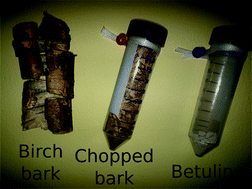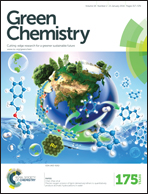Evaluation and analysis of environmentally sustainable methodologies for extraction of betulin from birch bark with a focus on industrial feasibility†
Abstract
Betulin from birch bark was extracted using two principally different extraction methodologies – classical Reflux Boiling (RB) and Pressurized Liquid Extraction (PLE). The extraction methods were analyzed based on both recovery and purity as well as for RB industrial feasibility. The purity and recovery for the different extraction methods were analyzed using High Performance Liquid Chromatography (HPLC) coupled with three different detection principles: Diode Array Detection (DAD), Mass Spectrometry (MS) and Charged Aerosol Detection (CAD). The chromatographic purity was determined by all detections whereas the DAD was used also for complementary gravimetric calculations of the purity of the extracts. The MS detection (in MS and MS/MS modes) was mainly used to characterize the impurities. Two steps to increase the purity of RB extracts were evaluated – pre-boiling the bark in water and precipitation by adding water to the extract. Finally, the methods were compared in terms of amounts of betulin produced and solvent consumed. The RB method including a precipitation step produced the highest purity of betulin. However, results indicate that PLE using three cycles with the precipitation step gives similar purities as for RB. The PLE method produced up to 1.6 times higher amount of extract compared to the RB method. However, the solvent consumption (liter solvent per gram product) for PLE was around 4.5 times higher as compared to the classical RB. PLE performed with only one extraction cycle gave results more similar to RB with 1.2 times higher yield and 1.4 times higher solvent consumption. The RB process was investigated on an industrial scale using a model approach and several important key-factors could be identified. The most energy demanding step was the recycling of extraction solvent which motivates that solvent consumption should be kept low and calculations show a great putative energy reduction by decreasing the ethanol concentration used in the RB process to lower than 90%.


 Please wait while we load your content...
Please wait while we load your content...